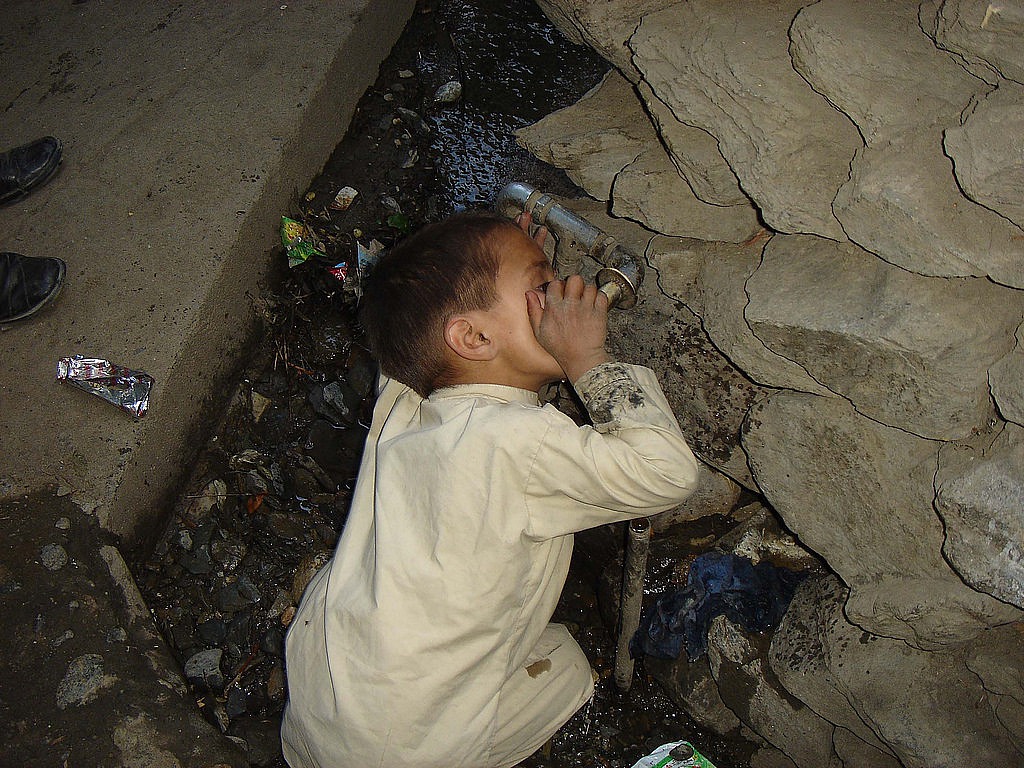
▲部分兒童死亡原因,可藉由提供乾淨水源來避免。圖片來源:Ground Report(CC BY-NC 2.0)
環境資訊中心 2017-03-08
摘譯自2017年3月6日ENS瑞士,日內瓦報導;姜唯編譯;蔡麗伶審校
根據世界衛生組織(WHO)發表的兩份最新報告,室內外空氣污染、二手菸、受污染的民生用水和衛生設施缺乏等環境風險每年導致170萬五歲以下孩童死亡。
報告指出,年齡一個月以上五歲以下兒童死亡的最主要原因,包括腹瀉、瘧疾和肺炎,都能透過改善環境、提供乾淨水源和乾淨的廚房燃料來避免。WHO秘書長陳馮富珍說:「環境污染能殺人,對小孩來說尤其如此。孩子發育中的器官和免疫系統、較小的體型和呼吸道,都讓他們特別容易受髒空氣和水的傷害。」
報告「傳承永續世界:兒童健康與環境輿圖」(Inheriting a Sustainable World: Atlas on Children's Health and the Environment)指出,環境污染可能影響胎兒,增加早產風險。室內外空氣污染和二手菸,會增加嬰兒和學齡前兒童罹患肺炎的機率,以及終其一生罹患氣喘等慢性呼吸道疾病的機率。空氣污染也會增加心臟疾病、中風和癌症的機率。

▲感染呼吸道融合病毒(RSV)的孩童。圖片來源:Lance McCord(CC BY-NC-SA 2.0)
另一份報告「別污染我的未來:環境衝擊對兒童健康的影響」(Don't pollute my future! The impact of the environment on children's health)詳細描述了各種污染對兒童健康的影響規模,包括:
新興的環境污染,像是未被妥善回收的電子垃圾,可能讓孩童接觸到有毒物質,損害智力、注意力、肺臟甚至致癌。而手機、電腦和螢幕等電子垃圾,預估將在2014至2018之間增加19%,2018年將達到全球5千萬噸。
兒童經由食物、水、空氣和產品接觸到有毒化學物質,像是
氟化物、鉛汞農藥、有機污染物和其他存在製造商品中,透過各種管道進入食物鏈的化學物質。
鉛會影響腦部發育,雖然含鉛汽油已經被大多數國家淘汰,但鉛仍大量存在油漆當中。
Pollution Kills 1.7 Million Children a Year
GENEVA, Switzerland, March 6, 2017 (ENS)
Every year, environmental risks such as indoor and outdoor air pollution, second-hand smoke, tainted water, lack of sanitation, and inadequate hygiene, take the lives of 1.7 million children under five years of age, warn two new reports from the World Health Organization.
One report, “Inheriting a Sustainable World: Atlas on Children’s Health and the Environment,” finds that a large portion of the most common causes of death among children aged one month to five years – diarrhea, malaria and pneumonia – are preventable by reducing environmental risks, and providing access to safe water and clean cooking fuels.
“A polluted environment is a deadly one – particularly for young children,” says Dr. Margaret Chan, WHO director-general. “Their developing organs and immune systems, and smaller bodies and airways, make them especially vulnerable to dirty air and water.”
The top five causes of death in children under five years are linked to the environment, says the World Health Organization, WHO.
Harmful exposures can start in the mother’s womb and increase the risk of premature birth. Then, when infants and pre-schoolers are exposed to indoor and outdoor air pollution and second-hand smoke they have an increased risk of pneumonia in childhood, and a lifelong increased risk of chronic respiratory diseases, such as asthma.
Exposure to air pollution also may increase their lifelong risk of heart disease, stroke and cancer.
A companion report, “Don’t pollute my future! The impact of the environment on children’s health,” provides a comprehensive overview of the environment’s impact on children’s health, illustrating the scale of the challenge.
Every year:
* – 570,000 children under five years die from respiratory infections, such as pneumonia, attributable to indoor and outdoor air pollution, and second-hand smoke.
* – 361,000 children under five years die due to diarrhea, as a result of poor access to clean water, sanitation, and hygiene.
* – 270,000 children die during their first month of life from conditions, including prematurity, which could be prevented through access to clean water, sanitation, and hygiene in health facilities as well as by reducing air pollution.
* – 200,000 deaths of children under five years from malaria could be prevented through environmental actions, such as reducing breeding sites of mosquitoes or covering drinking-water storage.
* – 200,000 children under five years die from unintentional injuries attributable to the environment, such as poisoning, falls, and drowning.
Emerging environmental hazards, such as electronic and electrical waste that is improperly recycled, expose children to toxins that can lead to reduced intelligence, attention deficits, lung damage, and cancer.
The generation of electronic and electrical waste, like old mobile phones, computers and monitors, is forecast to increase by 19 percent between 2014 and 2018, reaching an estimated 50 million metric tonnes worldwide by 2018.
Children are exposed to harmful chemicals through food, water, air and products around them. Chemicals, such as fluoride, lead and mercury pesticides, persistent organic pollutants, and other chemicals in manufactured goods, eventually find their way into the food chain.
Lead affects brain development. While leaded petrol has been phased out almost entirely in all countries, lead is still widespread in paints.
※ 全文及圖片詳見:ENS